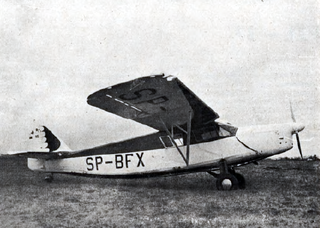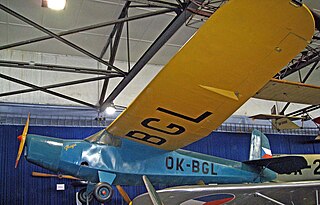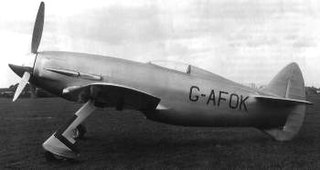
The Fairey Seafox was a 1930s British reconnaissance floatplane designed and built by Fairey for the Fleet Air Arm. It was designed to be catapulted from the deck of a light cruiser and served in the Second World War. Sixty-six were built, with two finished without floats and used as landplanes.

The RWD-15 was a Polish touring aircraft of 1937, designed by the RWD team and built by the Doświadczalne Warsztaty Lotnicze (DWL).

Desoutter is a British monoplane liaison aircraft manufactured by Desoutter Aircraft Company at Croydon Aerodrome, Surrey.

The Boulton Paul P.92 was a British design by Boulton Paul for a two-seat, turret-armed, twin-engine heavy fighter and ground attack aircraft to meet Air Ministry Specification F.11/37. Only a half scale prototype – the P.92/2 – was built and tested as check on aerodynamics before the project was cancelled in 1940.

The General Aircraft GAL.42 Cygnet II was a 1930s British single-engined training or touring aircraft built by General Aircraft Limited at London Air Park, Hanworth.

The Luton L.A.4 Minor was a 1930s British single-seat high-wing ultra-light aircraft. The prototype was built by the Luton Aircraft Limited, and design plans were later adapted and copies sold for homebuilding.

The Luton Buzzard was a 1930s British single-seat, open cockpit ultralight aircraft built by Luton Aircraft Limited.

The Praga E.114 was a single-engine sport airplane, designed and manufactured by the Czechoslovakian company ČKD-Praga. Due to its light weight it was also called Air Baby.

The Miles M.4A Merlin was a 1930s British five-seat cabin monoplane built by Miles Aircraft Limited.

The Heston Type 1 Phoenix was a 1930s British single-engined five-seat light transport monoplane built by the Heston Aircraft Company Limited.

The Napier-Heston Racer, also referred to as the Heston Type 5 Racer or Heston High Speed Aircraft J.5, was a 1940s British single-seat racing monoplane first conceived by D. Napier and Son Ltd., and built by the Heston Aircraft Company Ltd, for an attempt on the World Air Speed Record. The private venture was financed by William Morris, Lord Nuffield.

The Heston JC.6 was a British prototype air observation post aircraft designed and built by the Heston Aircraft Company Limited, who had previously built the Heston Phoenix, the Heston T.1/37 and the Napier-Heston Racer. The JC.6 was also known as the Heston A.2/45 or the Heston AOP.

The Comper Mouse was a 1930s British three-seat cabin monoplane designed by Nicholas Comper, and built by the Comper Aircraft Company at Heston Aerodrome in 1933.
Hordern-Richmond was a British aeronautical engineering company that traded between 1937 and c. 1990.
Heston Aircraft Company was a British aircraft manufacturer based at Heston Aerodrome, Middlesex, England.

The Parnall 382 was a 1930s British single-engined monoplane trainer aircraft with two open cockpits, designed and developed by Parnall Aircraft Ltd.

The Heston T.1/37 was a 1930s British single-engined monoplane military trainer aircraft with two open cockpits, designed and developed by Heston Aircraft Company Ltd. It was not accepted for service.

The Carden-Baynes Bee was a 1930s British two-seat aircraft, with twin engines in pusher configuration buried in the wings. The wings rotated for storage. Financial problems limited the Bee to a single flight.

The Waterman Arrowbile was a tailless, two-seat, single-engine, pusher configuration roadable aircraft built in the US in the late 1930s. One of the first of its kind, it flew safely but generated little customer interest, and only five were produced.
The Lebouder Autoplane was a French amateur built modular roadable aircraft, with a car-like component that could be separated from its aeronautical parts. The sole Autoplane flew and drove successfully in the early 1970s.

















